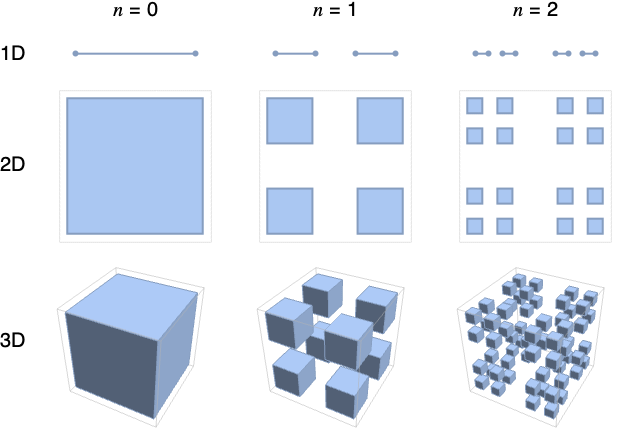CantorMesh[n]
gives a mesh region representing the n![]() -step Cantor set.
-step Cantor set.
CantorMesh[n,d]
gives the n![]() -step Cantor set in dimension d.
-step Cantor set in dimension d.




CantorMesh
CantorMesh[n]
gives a mesh region representing the n![]() -step Cantor set.
-step Cantor set.
CantorMesh[n,d]
gives the n![]() -step Cantor set in dimension d.
-step Cantor set in dimension d.
Details and Options

- CantorMesh is also known as Cantor dust.
- CantorMesh[n] is generated from the unit interval by repeatedly removing the middle third of the subsequent cells. »
- CantorMesh[n] is equivalent to CantorMesh[n,1].
- CantorMesh has the same options as MeshRegion, with the following additions:
-
DataRange Automatic the range of mesh coordinates to generate

Examples
open all close allBasic Examples (2)
Scope (4)
Options (13)
DataRange (1)
DataRange allows you to specify the range of mesh coordinates to generate:
MeshCellHighlight (2)
MeshCellHighlight allows you to specify highlighting for parts of a CantorMesh:
MeshCellLabel (2)
MeshCellLabel can be used to label parts of a CantorMesh:
MeshCellMarker (1)
MeshCellMarker can be used to assign values to parts of a CantorMesh:
Use MeshCellLabel to show the markers:
MeshCellShapeFunction (2)
MeshCellShapeFunction can be used to assign values to parts of a CantorMesh:
MeshCellStyle (3)
MeshCellStyle allows you to specify styling for parts of a CantorMesh:
Individual cells can be highlighted using their cell index:
Give explicit color directives to specify colors for individual cells:
Applications (4)
Properties & Relations (4)
The output of CantorMesh is always a full-dimensional MeshRegion:
CantorMesh consists of intervals in 1D:
The total length removed of the Cantor set is 1:
DataRange->range is equivalent to using RescalingTransform[{…},range]:
Use RescalingTransform:
Possible Issues (1)
CantorMesh can be too large to generate:
Related Guides
History
Text
Wolfram Research (2017), CantorMesh, Wolfram Language function, https://reference.wolfram.com/language/ref/CantorMesh.html.
CMS
Wolfram Language. 2017. "CantorMesh." Wolfram Language & System Documentation Center. Wolfram Research. https://reference.wolfram.com/language/ref/CantorMesh.html.
APA
Wolfram Language. (2017). CantorMesh. Wolfram Language & System Documentation Center. Retrieved from https://reference.wolfram.com/language/ref/CantorMesh.html
BibTeX
@misc{reference.wolfram_2025_cantormesh, author="Wolfram Research", title="{CantorMesh}", year="2017", howpublished="\url{https://reference.wolfram.com/language/ref/CantorMesh.html}", note=[Accessed: 22-November-2025]}
BibLaTeX
@online{reference.wolfram_2025_cantormesh, organization={Wolfram Research}, title={CantorMesh}, year={2017}, url={https://reference.wolfram.com/language/ref/CantorMesh.html}, note=[Accessed: 22-November-2025]}